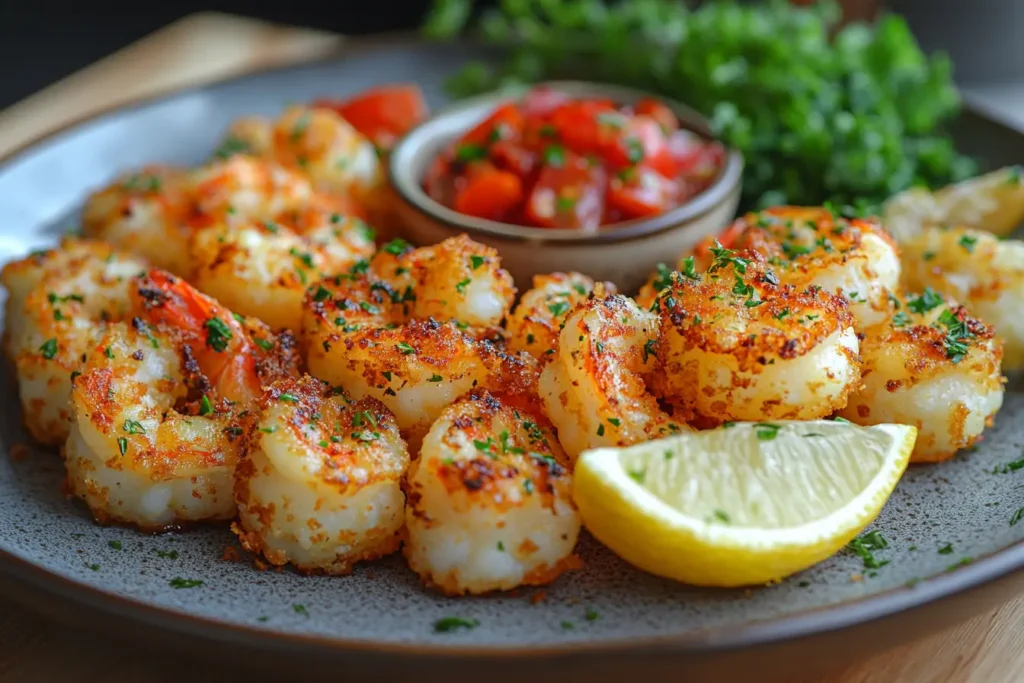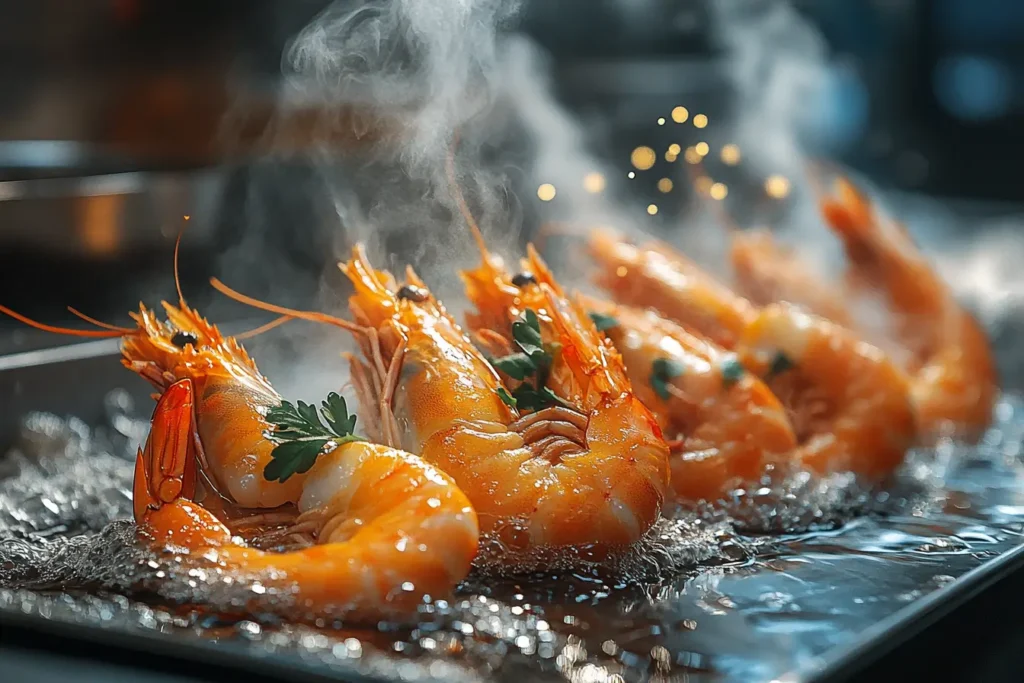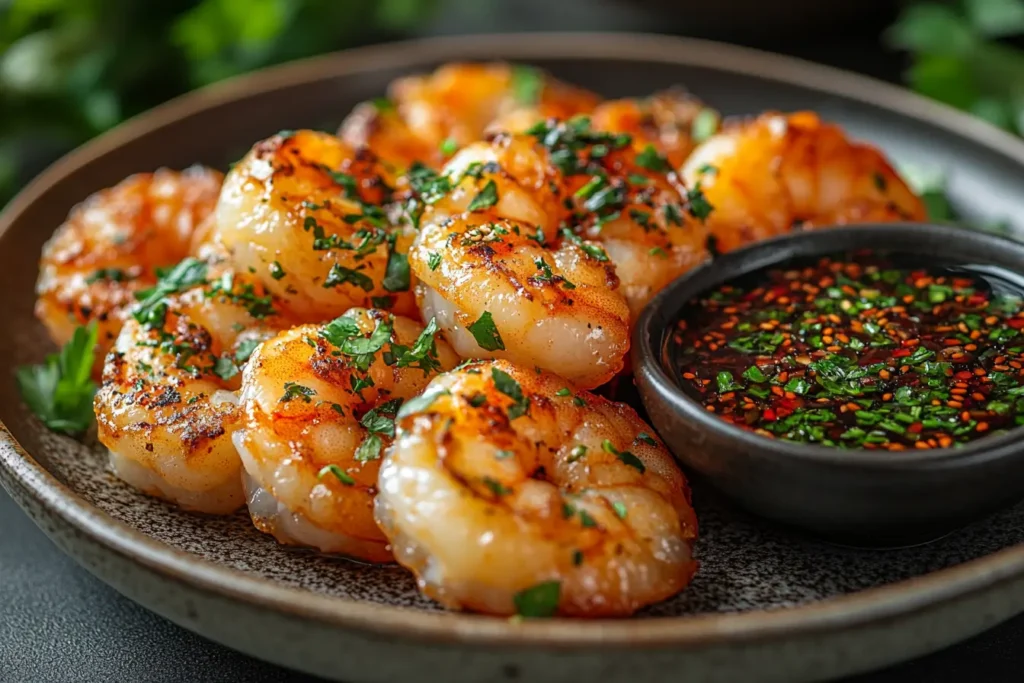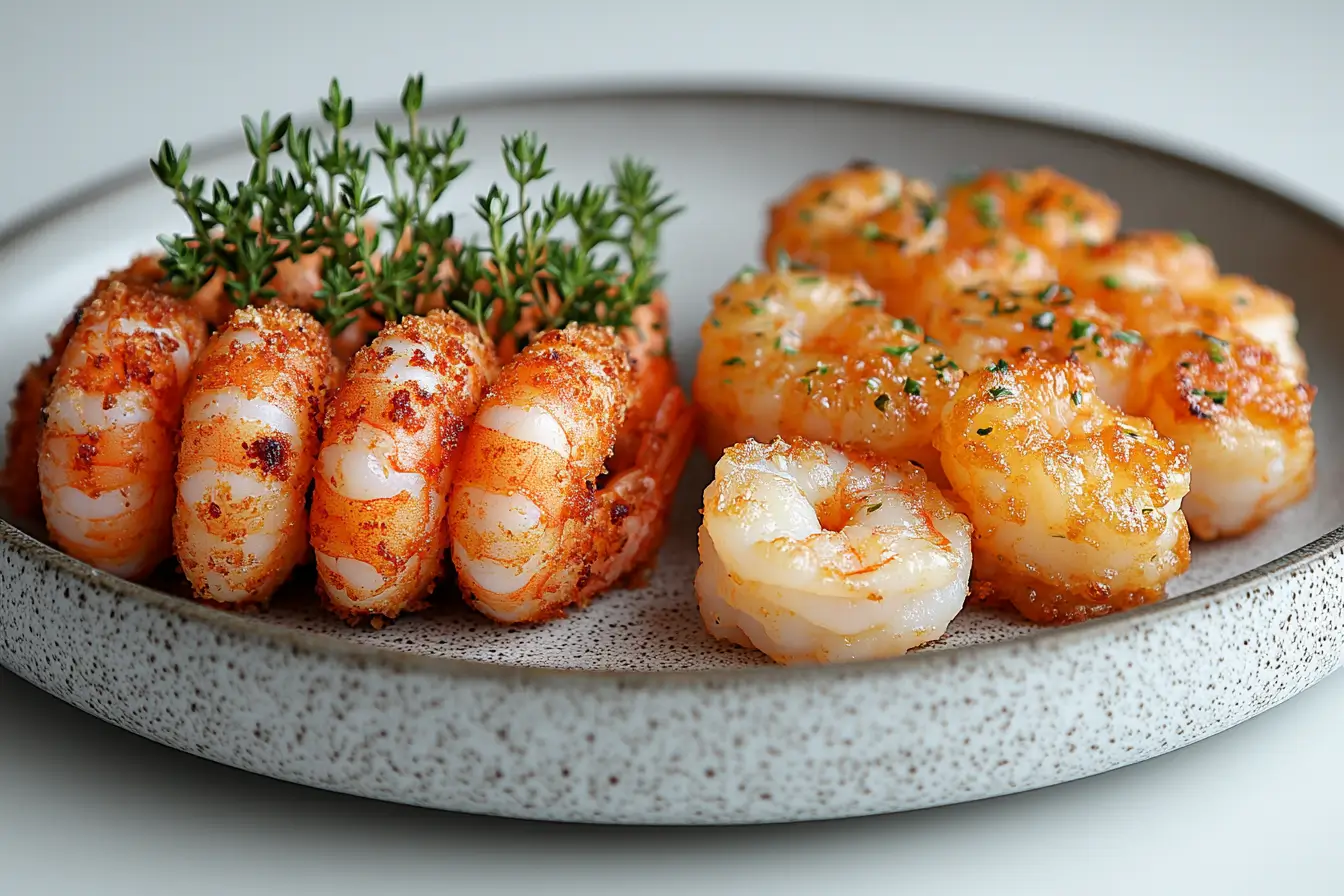
Introduction to Fried Shrimp and Tempura Shrimp
If you’re a seafood lover, you’ve probably wondered: what’s the real difference between fried shrimp and tempura shrimp? They’re both crispy, golden, and utterly delicious, but they each have their unique charm. Whether you’re dining at a Japanese restaurant or grabbing some comfort food at a local diner, understanding these two styles of shrimp preparation can elevate your appreciation of both dishes. Let’s dive into the details and uncover the crispy secrets! 🍤
Overview of Fried Shrimp
Fried shrimp is a classic comfort food loved around the world. Picture this: plump, juicy shrimp coated in seasoned bread crumbs or flour, fried to perfection in hot oil. The result? A crispy, crunchy exterior with a succulent interior that’s downright irresistible.
What sets fried shrimp apart is its versatility. You’ll often find it served with everything from tangy cocktail sauce to spicy remoulade. It’s a staple of Southern cooking, often accompanying hush puppies and coleslaw.
Overview of Tempura Shrimp
The Origins of Fried Shrimp and Tempura Shrimp
Now, let’s talk tempura shrimp. Originating from Japan, tempura is all about delicacy and lightness. Tempura batter is made with flour, cold water, and sometimes a bit of egg, creating a feather-light coating that enhances the shrimp’s natural flavor rather than overpowering it.
The magic of tempura lies in the frying technique. The batter is mixed just enough to keep it light and airy. When fried, the shrimp come out golden and crisp but not overly greasy. It’s a hallmark of Japanese cuisine, often served with a dipping sauce called tentsuyu.
History and Cultural Background of Fried Shrimp
Fried shrimp has roots in various culinary traditions. In the U.S., it’s most famously associated with Southern cuisine, where frying is practically an art form. From Louisiana’s Cajun shrimp to Florida’s Key West fried shrimp, the variations are endless. The breadcrumb coating often reflects local spices and flavors, making every bite a regional treat.
History and Cultural Background of Tempura Shrimp
Tempura, on the other hand, has a fascinating story. It was actually introduced to Japan by Portuguese missionaries in the 16th century. Over time, the Japanese refined the technique, making it their own. Tempura evolved into an elegant dish that’s now a staple in Japanese dining, embodying simplicity and precision.
Ingredients Used in Fried Shrimp vs. Tempura Shrimp
Typical Ingredients for Fried Shrimp
Fried shrimp recipes typically call for:
- Fresh or frozen shrimp
- All-purpose flour or cornmeal
- Breadcrumbs or panko
- Seasonings like salt, pepper, garlic powder, and paprika
- Oil for frying (peanut, vegetable, or canola)
The seasoning is key! You can play around with spices to give your fried shrimp a Cajun twist, a Caribbean vibe, or even an Italian flair.
Typical Ingredients for Tempura Shrimp
Tempura shrimp has a minimalist approach to ingredients:
- Fresh shrimp
- Tempura flour (or regular flour as a substitute)
- Ice-cold water
- Oil for frying (usually sesame or vegetable oil)
Unlike fried shrimp, tempura avoids heavy seasonings. The idea is to let the natural sweetness of the shrimp shine through.
Cooking Techniques: Fried Shrimp vs. Tempura Shrimp

Deep-Frying Techniques for Fried Shrimp
Fried shrimp thrives on high heat and a hearty coating. The shrimp are dredged in seasoned flour or breadcrumbs, then fried at around 350–375°F. The result is a crunchy, golden crust that locks in the juices.
Batter Preparation for Tempura Shrimp
Tempura shrimp requires a delicate approach. Prepare the batter just before frying to keep it cold, which helps achieve a crispy finish. Dip the shrimp into the batter and fry them in smaller batches to maintain a consistent oil temperature. Typically, tempura frying happens at 320–350°F, slightly cooler than traditional deep frying, ensuring a light and airy texture.
“When it comes to frying shrimp, temperature control is everything. Too hot, and you burn the coating; too cool, and you end up with greasy shrimp.” 🌡️
Texture and Flavor Differences
The Crispiness of Fried Shrimp
Fried shrimp is all about that crunch. The breadcrumb coating creates a satisfying texture that contrasts beautifully with the juicy shrimp inside. It’s a hearty dish that feels indulgent and satisfying.
The Lightness of Tempura Shrimp
Tempura shrimp, by contrast, is like biting into a crispy cloud. The batter is thin, airy, and lets the shrimp’s natural flavor take center stage. It’s less greasy than fried shrimp, making it feel lighter and more refined.
Common Accompaniments and Serving Styles
Traditional Sauces for Fried Shrimp
Fried shrimp is often paired with bold, tangy sauces. Some favorites include:
- Cocktail sauce
- Tartar sauce
- Spicy remoulade
- Ranch or blue cheese dressing for a twist
Dipping Sauces for Tempura Shrimp
Tempura shrimp keeps it simple and elegant. The go-to dipping sauce is tentsuyu, a mix of soy sauce, mirin, and dashi. For added flair, you might find grated radish or ginger served alongside.
Nutritional Comparison
Calories and Fat Content in Fried Shrimp
Fried shrimp is undeniably delicious, but it’s not the lightest option. The breading and frying process add extra calories and fat, especially if the oil isn’t drained properly.
Healthier Aspects of Tempura Shrimp
Tempura shrimp is slightly healthier due to its lighter batter and shorter frying time. However, it’s still a fried food, so moderation is key if you’re watching your calorie intake.
“Did you know? The Japanese word ‘tempura’ comes from the Latin ‘tempora,’ referring to the Lenten season when fried foods were eaten.” 🍤
Popular Dishes Featuring Fried Shrimp and Tempura Shrimp
Classic Dishes with Fried Shrimp
Fried shrimp is a star ingredient in countless dishes around the world. From seafood platters to po’boys, fried shrimp is versatile enough to fit any culinary setting. Here are a few examples:
- Shrimp Po’Boy
A beloved sandwich from Louisiana, the shrimp po’boy combines crispy fried shrimp with lettuce, tomatoes, pickles, and a generous slathering of remoulade sauce, all nestled in a French baguette. It’s comfort food at its finest! - Seafood Platter
In coastal regions, fried shrimp often takes center stage in seafood platters, served alongside fried fish, crab cakes, and hush puppies. It’s a feast for any seafood lover. - Bang Bang Shrimp
This dish elevates fried shrimp with a creamy, spicy sauce that adds a kick of heat and sweetness, making it perfect as an appetizer or a main course.
Tempura Shrimp in Japanese Cuisine

Tempura shrimp is equally versatile but leans toward a lighter, more refined style of presentation. Here are some popular ways it’s enjoyed:
- Tempura Shrimp with Rice
A simple yet satisfying meal, this dish pairs tempura shrimp with steamed rice and a side of dipping sauce. It’s a balanced combination that highlights the shrimp’s delicate flavor. - Shrimp Tempura Udon
A warm bowl of udon noodles topped with crispy tempura shrimp creates the perfect contrast between hearty and light. The tempura’s crunch adds an exciting texture to the soft noodles and broth. - Tempura Sushi Rolls
In fusion cuisine, tempura shrimp often finds its way into sushi rolls, adding a crispy element to the soft rice and fresh vegetables.
Common Problems When Making Fried Shrimp and Tempura Shrimp
Issues with Fried Shrimp
Making fried shrimp at home isn’t always smooth sailing. Here are some common challenges and how to tackle them:
- Greasy Texture
Greasy shrimp usually result from oil that’s too cold. When frying, the oil temperature should be between 350–375°F. Using a thermometer can help maintain the right heat. - Uneven Cooking
If some shrimp come out undercooked while others are overdone, it could be due to overcrowding in the pan. Fry in small batches to ensure even cooking. - Soggy Coating
A soggy coating is often caused by not letting the shrimp rest on a rack after frying. Avoid stacking them, as this traps steam and softens the crust.
Challenges with Tempura Shrimp
Tempura shrimp, while elegant, can be tricky to perfect. Here’s what could go wrong:
- Soggy Batter
If the batter absorbs too much oil, it becomes soggy instead of crisp. The secret is to use ice-cold water and fry at the proper temperature (320–350°F). - Clumpy Batter
Overmixing the batter creates a dense coating. Mix just until combined; lumps are okay—they’ll disappear during frying. - Burnt Edges
Burnt batter is often a sign that the oil is too hot. Using a thermometer is key to maintaining the perfect frying temperature.
Solutions to Perfect Fried Shrimp and Tempura Shrimp
Tips for Mastering Fried Shrimp
Want to nail fried shrimp every time? Try these tips:
- Season the Shrimp: Season the shrimp directly, not just the breading, for a punch of flavor in every bite.
- Use Panko Breadcrumbs: For an extra crispy coating, use panko breadcrumbs instead of regular breadcrumbs.
- Drain Excess Oil: Place fried shrimp on a wire rack, not paper towels, to drain oil. This prevents the shrimp from becoming soggy.
Tricks for Perfecting Tempura Shrimp
Making tempura shrimp might seem intimidating, but these tips can help:
- Keep the Batter Cold: Use ice-cold water and work quickly to keep the batter light and airy.
- Use the Right Oil: Opt for a neutral oil like vegetable or canola oil, which has a high smoke point.
- Don’t Overcrowd the Pan: Fry a few shrimp at a time to maintain consistent oil temperature and ensure a crisp coating.
“Here’s a pro tip: Freeze the shrimp for a few minutes before dipping them in tempura batter. It keeps the batter from slipping off during frying!” 🌟
The Appeal of Each: Which Is Right for You?
Why Choose Fried Shrimp?
Fried shrimp is perfect for those who love bold flavors and crunchy textures. It’s comforting, satisfying, and can be adapted to suit your taste. Whether you prefer a Cajun twist or a classic breadcrumb coating, fried shrimp is as versatile as it is delicious.
Why Choose Tempura Shrimp?
On the flip side, tempura shrimp is all about elegance and subtlety. If you enjoy light, crispy textures and want to highlight the shrimp’s natural sweetness, tempura is the way to go. Plus, it’s less greasy, making it a great choice for those seeking a lighter option.
Conclusion: Celebrating the Differences Between Fried Shrimp and Tempura Shrimp
At the end of the day, the choice between fried shrimp and tempura shrimp comes down to personal preference. Do you crave the bold crunch of fried shrimp, or do you prefer the delicate crispiness of tempura? Whichever you choose, both dishes offer a delightful way to enjoy shrimp. So why not try making both at home and decide for yourself? After all, when it comes to fried or tempura shrimp, the real winner is your taste buds! 🍤✨
Part 3: Deep Dive into the World of Fried Shrimp and Tempura Shrimp
Fried Shrimp and Tempura Shrimp in Global Cuisine
Fried shrimp and tempura shrimp have both transcended their origins, making waves in global cuisine. Let’s explore how these two preparations are enjoyed and celebrated around the world.
Fried Shrimp Around the Globe
Fried shrimp, with its crunchy exterior and juicy interior, is beloved in countless culinary traditions. Here’s how it’s enjoyed across the globe:
- Southern U.S.
In the American South, fried shrimp is often the star of seafood boils and platters. It’s served alongside hush puppies, fries, and a tangy cocktail sauce. Love crispy seafood? Don’t forget to explore the nuances of fried shrimp tails through Can You Eat Fried Shrimp Tails? for a surprising twist on this classic dish. - Southeast Asia
In regions like Thailand and Malaysia, fried shrimp is frequently spiced up with chili pastes and served with fragrant jasmine rice or spicy dipping sauces. - Caribbean
Here, fried shrimp is often paired with tropical flavors like mango salsa or coconut rice, creating a harmonious blend of savory and sweet.
Tempura Shrimp in Global Cuisine
While tempura shrimp is rooted in Japanese tradition, it’s now a favorite worldwide. Let’s take a closer look:
Japanese Tradition
In Japan, chefs typically serve tempura shrimp with rice or soba noodles. They pair it with a light dipping sauce made by combining soy, mirin, and dashi. Curious about what makes the batter so unique? Explore the Tempura Shrimp Recipe to master the perfect batter at home.
Fusion Cuisine
Sushi chefs frequently incorporate tempura shrimp into rolls, blending its crispiness with the soft textures of rice and raw fish.
Western Variations
In Western cuisines, many restaurants feature tempura shrimp as an appetizer or use it to top salads. Its light and crispy texture adds a delightful contrast to these dishes.
How to Choose Between Fried and Tempura Shrimp
If you’re still debating which shrimp preparation is best for you, let’s break it down based on a few scenarios:
When to Choose Fried Shrimp
Go for fried shrimp if you:
- Crave bold, hearty flavors.
- Prefer a thick, crunchy coating.
- Are pairing it with rich, tangy sauces like cocktail or tartar sauce. For more on its ingredients and unique textures, take a look at the related guide, Can You Eat Fried Shrimp Tails?.
When to Choose Tempura Shrimp
Tempura shrimp is your go-to if you:
- Appreciate delicate, subtle flavors.
- Love the idea of a light, airy batter.
- Want to enjoy it as part of a refined Japanese meal. Delve into its origins and make your own by following this Tempura Shrimp Recipe.
Final Thoughts: Combining the Best of Both Worlds
Why not experiment with both styles? You can host a shrimp tasting night, featuring fried shrimp, tempura shrimp, and even variations like coconut shrimp or spicy tempura rolls. For a more hands-on approach, start with learning the fundamentals in What is Shrimp Tempura Made Of? to perfect this elegant dish.
By understanding their differences and unique features, you’ll not only impress your taste buds but also gain a deeper appreciation for these two iconic shrimp preparations. So, grab your apron and frying pan—it’s time to enjoy the best of both worlds! 🍤✨

